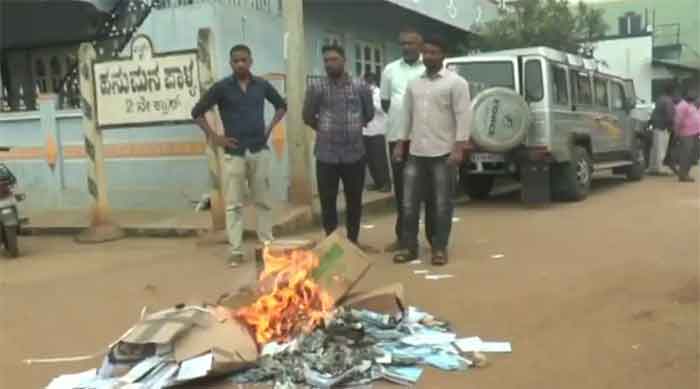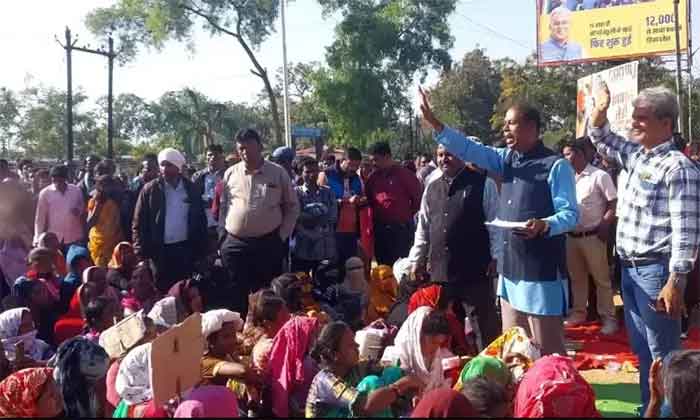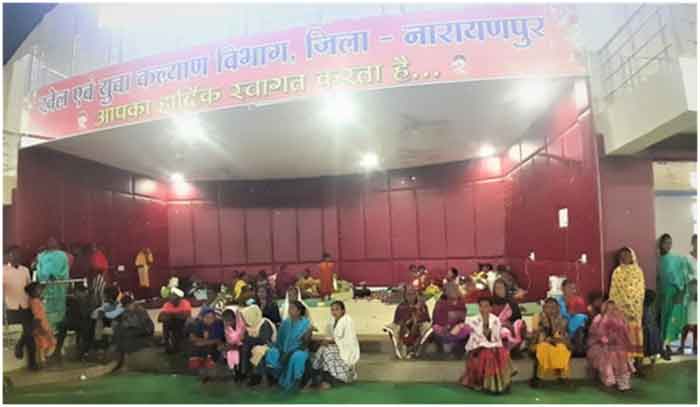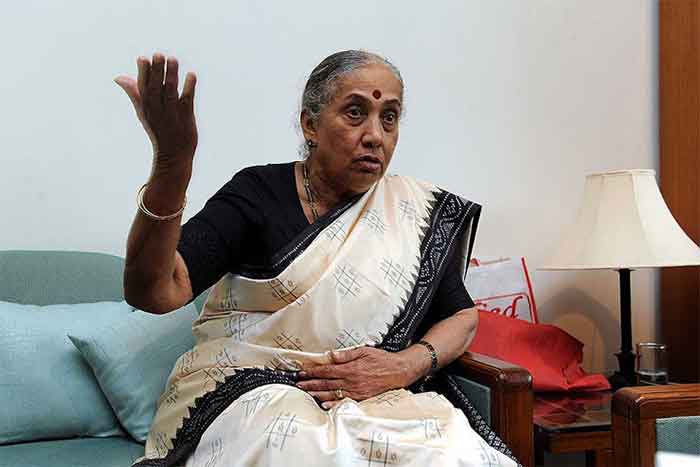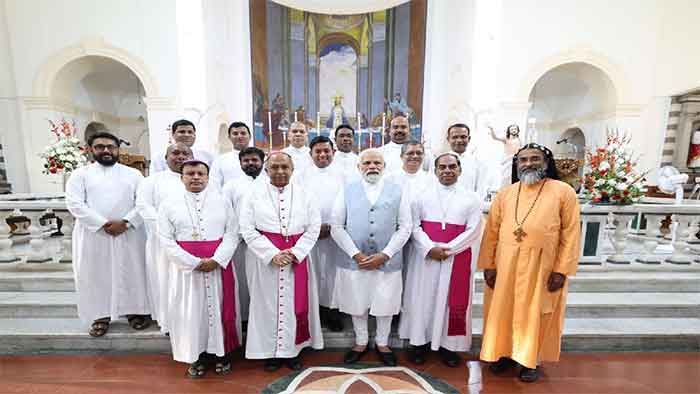
On Easter Monday, Malayali Catholics and the rest of the world woke up to the news that the BJP leaders in Kerala visited Catholic bishops on the eve of Easter. The BJP state vice-president even attempted to climb the Malayattoor hillock, one of the eight international shrines of the Catholic Church. The recent victories in the supposedly Christian-dominated Meghalaya and Nagaland seemed to have revived the saffron party’s urge for a breakthrough in Kerala, a state which has been relatively resistant to the electoral expansion of the party. Although the BJP has been approaching leaders of various Christian denominations for the last few years, of late, it is aggressively focusing on the powerful Syrian Catholic community of Kerala. The symbolism of the BJP leader’s attempted Malayattoor pilgrimage is not lost on anyone — the shrine of St Thomas, located in central Kerala, is also at the heart of the sacred geography of Syrian Catholics. As per community traditions, Thomas the Apostle is believed to have founded the community of Nasrani/ Syrian Christians by allegedly converting a few Namboothiri Brahmin families in what today is Kerala in the first century CE.
Among the Christian population in Kerala, the Syrian Catholic laity constitutes a potentially strong vote bank, one that is generally considered to be at the beck and call of the Church leadership. However, it may not be accurate to describe the BJP as ‘wooing’ Syrian Catholics anymore; the prelates are now openly welcoming the Sangh Parivar political outfit into their arms. We are witnessing an elaborate, spectacular courtship whose ‘communal’ angle is what receives the most attention, and rightly so. But the strong caste angle undergirding this nexus, ‘unholy’ by any reasonable Catholic and Christian ethical standards, goes glaringly missing in such critical responses. It may be erroneous to equate the stances of the clergy with that of the rank-and-file Syrian Catholic laity. Yet, the emerging political courtship between Syrian Catholic leadership and the Hindutva party is based on a solid social consensus shaped by caste. Let us consider a few aspects of this social consensus.
An ample number of sociologists and anthropologists have studied the seamless cultural universe the Syrian Christians have been sharing with caste Hindus in Kerala for centuries. The resultant cultural Hinduness is therefore shared by the Syrian communities in Kerala comprising not only Catholics but also a significant percentage of non-Catholic communities distributed across the Orthodox, Jacobite, Marthoma, and other Protestant denominations. Syrian Christians have borrowed many ‘Hindu’ practices such as horoscope, astrological observances like ‘auspicious’ times for marriage, rituals of magic, and birth and death pollutions, to mention a few. The advance of the evangelical, Charismatic movement within the Catholic Church, especially since the 1990s, has attempted to push some of these practices to the periphery. Still, the continuing sermonising against such ‘unchristian’ practices indicates their resilience. At the root of this cultural Hinduness is caste, an institution in which the Nasrani Christians have actively participated for centuries. And the myth of the Brahmin pedigree of Syrian Christians has been the peg anchoring this shared caste-based socio-cultural affinity. The shared Hinduness contributed to the socio-economic clout Syrian Christians enjoyed in the region historically. As caste shaped the faith practices of Syrian Catholic communities in Kerala, dissenting voices like those of Paremakkal Thoma Kathanar, an eighteenth-century prelate, remained lone (as is the case today). The dominant castes even appointed the Nasrani as the cleanser-cum-absorbent of caste pollution they imbibed upon contact with lowered castes. Therefore, despite the ‘foreignness’ of their belief, Syrian Christians, including Nasrani Catholics, became a caste in and for itself.
Barring a few exceptions, studies on caste among Malayali Christians have tended to focus on non-Catholics in Kerala. The role of caste in the formation of Syrian Catholic identity requires greater scholarly attention, given the dominance the community enjoys among Christians and the larger Malayali public. Officially, the Church debunks the Brahmin origin myth of the Nasrani Christians, at least in the liturgical classes where Catholic social teachings are taught. But the rate and extent of diffusion of the ‘official policy’ within and outside the community seem negligible. Syrian Catholics continue to lay genealogical claims to Pakalomattam or any other ‘original’ Brahmin-Nasrani families whom Thomas the Apostle reportedly converted to Christianity. From Kudumba Yogams (family gatherings) and Kudumba Charithrams (chronicled family histories) to marriage alliances to seemingly casual enquiries while socialising in the churchyard after Holy Mass, kinship proximity to the original Nasrani homesteads is always gauged. This invocation of Brahmin pedigree finds expression in Malayalam acronyms like ‘Athi Purathana Katholica Kudumbam’ (A. Pu. Ka. Ku. or Pu. Ka. Ku.), meaning ‘ancient (read aristocratic) Catholic family’. The term has received greater currency in the region thanks to a genre of post-1990s low-brow Malayalam cinema. The very imagined community of ‘A. Pu. Ka. Ku.’ summons its reprehensible Other: The Puthu Kristiani (Pu. Kri.), meaning ‘newly converted Christians’ or neo-Christians. In fact, ‘Pu. Kri.’ has been a common slur Syrians use to refer to Dalit Christians. This writer has witnessed Syrian Catholic individuals using the term as a racist, body-shaming insult to describe family members of darker complexion because, as per this reasoning, Syrian Christians can only have a fairer ‘Aryan complexion’!
The constant invocation of kinship claims to Nasrani aristocracy requires us to understand the place of Brahminical patriarchy in cementing Syrian Christian identity. Today, demographic shifts have left the community with more unmarried men, and that too of relatively lesser educational qualification and professional status than Syrian Catholic women. For instance, about a decade ago, Church leadership openly expressed concerns about Syrian Catholic girls marrying (non-Catholic) ‘auto drivers’ — referring to the blue-collar class as if the community did not have that stratum of working population. Today, Pre-Cana (mandatory pre-marriage course organised by the Church) counsellors advise women to choose a Catholic partner by considering the ‘quality of character and faith’ over material status. In this scenario, women who choose to marry outside Syrian Christianity face a tough time negotiating the hostility and covert violence by the community.
Complicating the matter of female agency within the community further is the global and national climate of Islamophobia, which has birthed the bogey of ‘Love Jehad’. However, not enough attention has been paid to an equally unproven accusation of ‘Ezhava Jehad’: an oxymoronic term used by some Syrian Catholic priests to suggest an alleged conspiracy by Ezhavas, an ex-untouchable community (and other oppressed caste men) to ‘lure’ Syrian Christian women. Even if women marrying outside the community wish to retain their Catholic faith, a right they are entitled to under Canon law, they must undergo punishing and often humiliating bureaucratic procedures. At the same time, alliances between Nair or Namboothiri men and Syrian Catholic women, despite their frequency, do not invite the kind of vitriol that Muslim-Christian or inter-caste marriages routinely attract.
On the other hand, it is not puzzling at all that caste Hindu Malayali men speak derisively of ‘biscuit Christians’ and ‘rice-bag converts’ without any qualms about courting and/or marrying Syrian Catholic women (although they are not likely to let her practice her faith or raise their children as Christians). The advance of the Hindutva ideology in Kerala might have amplified anti-Christian sentiments among caste Hindus. But the mythical Namboothiri origin story of the Syrian Christians tempers the hatred for the ‘non-Indic’ faith. Meanwhile, the distinctive caste status of ‘Malayali Christians’ propagated through popular culture forms like movies and Syrian Christian cuisine has begun to achieve pan-India appeal. Consider the 2010 box-office hits by the Tamil-Malayali film director Gautham Vasudev Menon, viz, Vinnaithaandi Varuvaaya (Tamil), its Telugu version Ye Maya Chesave and the not-so-successful 2012 Hindi remake (Ekk Deewana Tha): these movies celebrated if not fetishised its ‘Malayali Christian’ heroines hailing from central Kerala, the Syrian Christian stronghold. The implicit caste status of ‘simple’ sari-clad Jessies and Annies from Kerala places them a notch above the (more) Westernised, miniskirt-wearing Sandras from Bandra. ‘Malayali Christian’ characters have appeared in more Bollywood and non-Malayalam productions since. Wait before you discredit this newfound appeal of the ‘Kerala Christian’ as a popular culture fad: Syrian Christians are more likely to find rented apartments without much fuss in cities across India than Muslims and Dalits. The shared Hinduness of Syrian Christians gaining traction across India grants them certain privileges and immunises them from the Hindutva hatred faced by other Christians and minorities today.
So, when Cardinal George Alencherry, the head of the Syrian Catholic Syro Malabar Church, says that ‘Christians’ need not feel insecure in ‘BJP-ruled India’, the prelate is talking exclusively about Syrian Christians in Kerala. A popular everyday refrain among Syrian Christians is ‘Kudumbathil Piranna Kristiani’, meaning ‘a Christian of superior family/ homestead’, a definition harking back to the supposed Brahmin descent. The usage can be translated as the Syrian Christian definition of an authentic Christian. The definition of the Christian who is at home in BJP-ruled India presupposes this cultural understanding of the true (Brahmin) Christian subject comfortably nestled within the ‘Hindu’ cosmos. By the same logic, the victims of the increasing number of attacks in India in the name of ‘conversion’ are not authentic Christians then. Nor is Stan Swamy, the Dalit Catholic priest-cum-theologian who languished to death in prison under dubious charges (Kerala Catholic Bishop’s Council/ KCBC’s condolence statement notwithstanding). Stan would have had a better shot at being counted as an authentic Christian had he taken up causes affecting the Syrian Catholics of God’s Own Country. Alas, the priest chose to work for Dalits and Adivasis in some ‘godforsaken’ corner of India. The same idea of the authentic Christian probably informs the lack of zeal in Syrian Catholic advocacy for the reservation of Dalit Christians. On the other hand, the enthusiasm for the EWS reservation, even if Communists implement it, is telling.
However, it is remarkable that the real possibility of a frenzied group not bothering to assess the aristocratic origins of individuals before lynching them escapes the attention of the clergy. Catholic nuns, including Syrian Christians working as missionaries, medical professionals and teachers in northern Indian states, are particularly vulnerable to Hindutva attacks. Already, the burden of labour which Catholic women religious in India bear is disproportionate to that of men. The Church is often oblivious to their hardships, including the sexual violence they face from within. Their perilous existence in a hostile religious climate is thus easily overlooked over more ‘pressing’ concerns like ‘Love Jehad’. Or their sufferings are leveraged through strategies like beatification, as in the case of Sr Rani Maria, who was ruthlessly murdered in Indore in 1995.
One need not venture further than Kerala to understand the Syrian Christian community’s selective application of the category of ‘Christian’. The Church prelates have repeatedly based their pro-Sangh stances in terms of the state apathy shown to small-scale farmers in Kerala. These once-thriving farmers, most of whom had migrated to the hill ranges in northern Kerala since the 1960s are at the receiving end of neoliberal agricultural policies, environmental degradation, and climate change-induced crises, including human-wildlife conflicts. In popular representations, and especially in Church narratives, the small-scale migrant farmer is a Syrian Catholic, regardless of their heterogeneity. Even if state indifference towards Catholics is the criterion for the new political courtship, a community of Malayali Catholics deserves the Church’s urgent consideration: the predominantly Latin Catholic fishing communities of coastal Kerala. Due to development policies and climate change, manifesting as coastal erosion and cyclones, Kerala’s coastal communities face an existential crisis. The predicament of these Catholics is comparable to, if not graver than, the plight of Syrian Catholic farmers today. A trip along the coastline from Thumba to Anjuthengu in the Thiruvananthapuram district opens your eyes to the precarity of coastal lives. In many places, modest concrete compound walls separate the houses of fishing communities from the roaring seas. The Bible verses painted on these walls seem to be their only refuge from the invading seas. But how many Syrian Catholic prelates argue for these ‘other’ Catholics with the same vigour they show for the plight of migrant farmers?
In a recent protest helmed by the predominantly Latin Catholic protestors at Vizhinjam against the Adani Port, the ruling party in the state (CPIM) and at the centre (BJP) were on the same side against the coastal community. Aside from token condemnations and calls for ‘dialogue’ issued by KCBC (an organisation of all Catholic denominations in Kerala), the Syrian Catholic prelates were silent. It must be noted that the strong undercurrent of Islamophobia taking hold of the Latin community did not endear them enough to the Sangh party. In contrast, the state BJP leaders do not miss an opportunity to echo and amplify Syrian Catholic tirades against Muslims. The history of caste discrimination Latin Catholics faced from dominant castes, including the Syrian Christians, has exacerbated their marginalisation by the state. Today the Syrian Catholic churches may adeptly use the fig leaf of rite and denominational differences to conceal their repulsion for the Latin Catholic communities. Nevertheless, the virulence of caste disdain, particularly in the Travancore region, is a fact observed first-hand by this writer and corroborated (privately, of course!) by Catholic priests of both denominations.
It then appears that the security ‘Christians’ feels in India is directly proportional to the extent of their integration within the ‘Hindu’ socio-cultural universe and apparent political clout. For the Syrian Catholic leadership that peddles narratives of victimhood at the hand of real and imagined adversaries, the travails of an individual like Stan Swamy or groups like Latin Catholics and the Dalit Christians (forget other minorities) within and outside Kerala may not merit passionate defence of the kind reserved for Syrian Catholic causes. When caste-class interests of Syrian Catholics are at stake, realpolitik considerations kick in. The definition and scope of ‘Christian’ and ‘marginalised Catholics’ shrinks. Voices from other denominations resist the pro-Sangh narrative crafted by the Syrian Catholic Church. But the impending saffron slide of the relatively powerful Syrian Catholic churches will have implications for Kerala society and politics.
Ironically, while the ‘dictatorship of relativism’ is a central theme in Catholic diagnoses of the modern world elsewhere, the Syrian Catholic Church in Kerala is involved in a macabre exercise of the same. The question posed in the title should then be modified to ‘Which Christian Can be at Home in BJP-Ruled India?’. The Syrian Catholic clergy seems to be stating that a Christian most likely to feel secure in India today belongs to its flock. However, as things stand now, entry into the Household is only by birth, reserved eternally for the ‘Kudumbathil Piranna Kristhiani’.
The author is a research scholar

